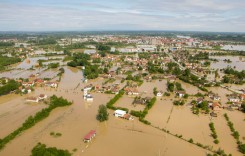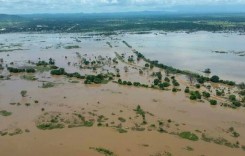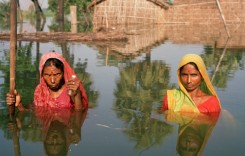A recent report by the UN, “The Human Cost of Weather Related Disasters”, reveals that in the last 20 years, 157,000 people have died as a result of floods.
The report also says that between 1995 and 2015, floods affected 2.3 billion people, which accounts for 56% of all those affected by weather-related disasters – considerably more than any other type of weather-related disaster.

The report and analysis, compiled by the UN Office for Disaster Risk Reduction (UNISDR) and the Belgian-based Centre for Research on the Epidemiology of Disasters (CRED), says that between 1995 and 2015, there were 3,062 flood disasters, which accounted for 47% of all weather-related disasters and 43% of all natural disasters combined, which also includes geophysical hazards such as earthquakes and volcanoes.

Increasing Frequency and Severity of Floods
The report points to an alarming trend of flood disasters affecting ever wider areas, while at the same time becoming more severe. Furthermore, flooding has taken its toll on agriculture and food supplies, exacerbating malnutrition problems in poorer areas of the world.
Floods Increasing Across the World
According to the report, floods strike in Asia and Africa more than other continents, but pose an increasing danger elsewhere. In South America, for example, 560,000 people were affected by floods on average each year between 1995 and 2004. By the following decade (2005-2014) that number had risen to 2.2 million people, nearly a four-fold increase. In the first eight months of 2015, another 820,000 people were affected by floods in the region.
This trend has continued into late 2015 where overflowing rivers forced over 100,000 from their homes in Brazil, Uruguay, Argentina and Paraguay.
More Lives Lost
The report also says that death tolls from flooding have risen in many parts of the world. In 2007, floods killed 3,300 people in India and Bangladesh alone. In 2010, flooding killed 2,100 people in Pakistan and another 1,900 in China, while in 2013 some 6 ,500 people died due to floods in India.
Flood Events Becoming More Severe
The nature of disastrous floods has also changed in recent years, with flash floods, acute riverine and coastal flooding increasingly frequent. In addition, urbanization has significantly increased flood run-offs.
Floods and Food Shortages
Recurrent flooding of agricultural land, particularly in Asia, has taken a heavy toll in terms of lost production, food shortages and rural under-nutrition.
This situation can currently be seen in Malawi, which suffered some of its worst floods in history at the start of 2015, and is now facing its worst food shortages in a decade.
According to the report, in rural India, children in households exposed to recurrent flooding have been found to be more stunted and underweight than those living in non-flooded villages. Children exposed to floods in their first year of life also suffered the highest levels of chronic malnutrition due to lost agricultural production and interrupted food supplies.
Flood Disaster Prevention
The report states that many of these impacts are preventable since flooding – unlike most types of weather-related disasters – lends itself to primary prevention through affordable technologies such as dams and dykes, while measures such as education of mothers have also been shown to be effective in protecting children from flood-related malnutrition.
In its conclusion on flood disasters, the report says:
“In view of the serious health and socio-economic impacts of flooding, CRED and UNISDR believe that flood control should be regarded as a development issue as well as a humanitarian concern. Priority should be given to cost- effective mitigation measures in poor regions at high risk of recurrent flooding, together with malnutrition prevention programmes.”
The report says that effective low-cost solutions exist for flood protection, such as afforestation, reforestation, floodplain zoning, embankments, better warnings and restoration of wetlands.
Recently 10 African countries, including Malawi, committed to restoring 31 million hectares of degraded and deforested land.
Sri Lanka and Indonesia have both recently embarked on restoration and protection of mangroves to increase coastal flood protection.

90% Major Disasters are Weather Related
The report also looks at the wider causes of disasters over the last 20 years and finds that 90% of major disasters have been a result of weather-related events, such as floods, storms, heatwaves and droughts. In fact, during that time as many as 6,457 weather related disasters occurred.
CRED classifies hydrological, meteorological and climatological events as weather-related hazards. Other disasters may be a result of geophysical hazards such as earthquakes and volcanoes, or biological hazards such as epidemics.
According to the report, an average of 335 weather-related disasters were recorded per year between 2005 and 2014, an increase of 14% from 1995-2004, and almost twice the level recorded during 1985-1995.
Across the globe, over 600,000 lives have been lost – an average of 30,000 per year. Over 4 billion people have been injured, left homeless or in need of emergency assistance, and 87 million homes damaged or destroyed as a result of weather-related disasters in the last 20 years. While less frequent than floods, storms were found to be the deadliest type of weather-related disaster, accounting for 242,000 deaths or 40% of the global weather-related deaths, with 89% of these deaths occurring in lower-income countries.
Asia bore the brunt of weather-related disasters, with more frequent events and greater numbers of people killed and affected than any other continent . This is due mainly to Asia’s large and varied landmass, including multiple river basins, flood plains and other zones at high risk from natural hazards, plus high population densities in disaster-prone regions. In total, 2,495 weather-related disasters struck Asia between 1995 and 2015, affecting 3.7 billion people and killing a further 332,000 individuals.
In terms of countries, of the five nations hit by the highest number of disasters, the two worst affected by far are the United States (472) and China (441), with India (288), Philippines (274), and Indonesia, (163) making up the top five.

Economic Losses
Those weather related disasters accounted for US$1.891 trillion in economic losses. However the report highlights data gaps. Only 35% of records include information about economic losses, and that economic losses from weather-related disasters are likely much higher than the recorded figure. UNISDR estimates that the true figure on disaster losses – including earthquakes and tsunamis – is between US$250 billion and US$300 billion annually.
Introducing the report, Ms. Margareta Wahlström, then head of UNISDR, said: “Weather and climate are major drivers of disaster risk and this report demonstrates that the world is paying a high price in lives lost. Economic losses are a major development challenge for many least developed countries battling climate change and poverty.
“In the long term, an agreement in Paris at COP21 on reducing greenhouse gas emissions will be a significant contribution to reducing damage and loss from disasters which are partly driven by a warming globe and rising sea levels. For now, there is a need to reduce existing levels of risk and avoid creating new risk by ensuring that public and private investments are risk-informed and do not increase the exposure of people and economic assets to natural hazards on flood plains, vulnerable low-lying coastlines or other locations unsuited for human settlement.”
Professor Debarati Guha-Sapir, head of CRED, said: “Climate change, climate variability and weather events are a threat to achieving the Sustainable Development Goals’ overall target of eliminating poverty. We need to reduce greenhouse gas emissions and tackle other risk drivers such as unplanned urban development, environmental degradation and gaps in early warnings. This all requires ensuring people are risk informed and strengthening institutions which manage disaster risk.”
The report concludes that economic losses from weather- and climate-related disasters have been heavily influenced by increasing exposure of people and economic assets. Better management, mitigation and deployment of early warnings could save more lives in future.
See the full report: “The Human Cost of Weather Related Disasters” here (PDF).









s.k.srinivasan
- Edit
i feel really sorry about this picture